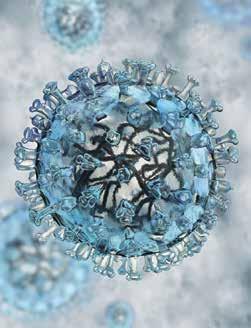Adviser:
Stefan Gravenstein, MD, MPH
Professor, Case Western Reserve University, Cleveland, Ohio
Adjunct Professor, Alpert Medical School of Brown University and Clinical Director, Healthcentric Advisors, Providence, Rhode Island
In collaboration

Adviser:
Stefan Gravenstein, MD, MPH
Professor, Case Western Reserve University, Cleveland, Ohio
Adjunct Professor, Alpert Medical School of Brown University and Clinical Director, Healthcentric Advisors, Providence, Rhode Island
In collaboration
Immunosenescence, or immunologic aging, is a primary cause for autoimmunity problems and increased infectious disease susceptibility, morbidity, and mortality with advancing age. Pneumonia, urinary tract infections, and skin infections stand out as the most common infections among the oldest age groups. But vaccine-preventable infections, such as influenza, pneumococcal infection, tetanus, pertussis, and diphtheria, also increase with age—the former 2 of these despite vaccination. Immunosenescence also results in the atypical presentation of infections in old age, with infections being more frequent and prolonged in older adults.1,2 Older adults may present with infections secondary to unusual organisms, recurrent infections with the same pathogen, or reactivation of quiescent diseases, such as tuberculosis and herpes zoster. Older adults may respond suboptimally to standard therapy for infection. Similarly, although vaccinations are effective in reducing disease in older adults, immunosenescence blunts their effects. Nevertheless, few efforts have proven as useful in enhancing immunity and preventing disease as vaccination, and newer vaccines employ strategies to further strengthen the immune response.
This issue of WHAT’S HOT focuses on issues surrounding immunosenescence, infectious disease, and vaccination as a way to mitigate the effects of aging on

immunity. In November 2012, the GSA 65th Annual Scientific Meeting, Charting New Frontiers in Aging, featured several symposium and poster presenters who are charting new connections among immunosenescence, aging, and disease. Researchers reported their findings on immunosenescence as it relates to frailty, life span, and inflammation, as well as discussed how genetics, geography, and socioeconomics affect aging status. These presentations offered clinicians, researchers, policymakers, and others with stateof-the-art information about aging and highlighted new concepts that are on the horizon for improving health.
Immunosenescence is a complex process that, despite significant advances, is still not fully understood. Although genetic disposition determines much of the aging process, several factors external to aging are hypothesized to affect immunosenescence, both positively and negatively: oxidative stress, gender differences, chronic viral infections (eg, cytomegalovirus), sociodemographic factors, unhealthy habits, comorbidities, medications, malnutrition, and exercise.3
In addition to lifestyle changes, vaccination has been proposed as one of the few pharmacologic strategies that may help mitigate the clinical consequences of immunosenescence. Vaccines formulated with higher doses than standard formulations (ie, varicella and influenza) have proven to boost immune response in older adults when compared to the original vaccines.4,5
Several researchers have proposed that autoimmunity plays an important role not only in aging but also in the ongoing regenerative and reparative process that occurs during aging. Autoimmunity affects muscle
Influenza, or the flu, is a highly contagious respiratory illness caused by viruses that infect the nose, throat, and lungs. In general, symptoms for those infected with influenza include fever or chills, cough, sore throat, headache, fatigue, and myalgia; severity ranges from mild to severe. In healthy adults, symptoms typically last from 3 to 8 days and gradually diminish. Respiratory symptoms are caused directly by influenza virus that is present locally; systemic symptoms, such as fatigue and myalgia, are caused by the body’s immune response, particularly cytokines released secondary to infection.6,7 Adults are typically infectious 24 hours before symptom onset and remain infectious for approximately 7 days.
Influenza primarily attacks the respiratory tract and seldom spreads systemically; however, evidence suggests that it can precede clinically important respiratory and nonrespiratory disease. Influenza can cause more than just viral pneumonia because it results in a systemic thrombogenic inflammatory response. Epidemiologic studies have shown that influenza can precede vascular events in older adults, including heart attack, heart failure, and stroke.8,9,10 Some experts believe that influenza vaccine can prevent thrombotic outcomes, such as heart attacks, mechanistically by reducing the overall inflammatory response through targeted priming of the immune system.
Influenza disproportionately affects older adults, not only more often but also more severely. Influenza is the most common viral infection of older adults, and the majority of infectious morbidity and mortality in late life is caused by
homeostasis, glucose metabolism, oxidative stress, and other important body functions (see Figure 1). In addition to certain autoimmune diseases that have their highest incidence in older adults, such as rheumatoid arthritis and bullous


• Innate immunity
• Endocrine function
• Neural function
• Cardiovascular health
• Muscle homeostasis
• Glucose metabolism
• Oxidative stress

Proinflammatory cytokines and frailty
pemphigoid, autoimmunity also plays a role in pernicious anemia, vascular disease, and cancer. The outcomes of these conditions include nursing home placement, increased health care costs, excess morbidity, and mortality.
T cell mediated immune system dysregulation

Immunosenescence
• Native CD4+ T cells
• Loss of specificity
• Signaling changes
• T cell proliferation
Immunosurveillance Immune risk phenotype

• Anemia of chronic diseases
• Autoimmune disorders
• Cancer
• Cardiovascular diseases
• Infection
• Metabolic diseases
• Neurodegenerative diseases
• Protein energy malnutrition
Nursing home residency, increasing cost, morbidity, and mortality

Adapted from Fulop et al. Aging and Infectious Disease 2009;48:443-8.
influenza and pneumonia. In addition, clinical presentation of influenza in older patients may be different from that in younger patients. Older adults tend to have fewer symptoms, and fever may be absent. In general, signs of infection in older adults can be nonspecific and include malaise, poor appetite, falls, delirium, or generalized weakness.
Nursing facility residents represent a unique subset of older adults who are especially vulnerable to the effects of influenza. Their immune and physiological senescence, multimorbidity, and high exposure risk through close living quarters and shared caregivers contribute to their greater susceptibility to infection. Influenza signs and symptoms are not always evident in older
adults, complicating diagnosis. Influenza may or may not directly lead to hospitalization, but lower respiratory tract infections are associated with considerable morbidity that can result in hospitalization. Hospitalization rates for long-term care residents vary considerably between facilities, but the majority of hospitalizations occur during the 12 weeks during which influenza peaks each year.
Several abstract summaries of relevant research are included here to highlight new information about vaccinations in older adults. These articles were chosen to show how vaccination may affect immune response differently in older adults than in younger populations or provide additional benefits to this high-risk group.
P. L. Gozalo; A. Pop-Vicas; Z. Feng; S. Gravenstein Brown University, Providence, RI
Nursing home residents’ vulnerability to the adverse effects of influenza derives from underlying frailty, reduced immune competence, and high exposure risk as a consequence of close living quarters with shared caregivers. As with community-dwelling older adults, influenza in nursing facility residents can exacerbate preexisting cardiovascular, cerebrovascular, and respiratory conditions and often leads to hospitalization and death. Despite the current understanding of influenza in nursing homes, relatively little is known about how much it affects function, such as activities of daily living (ADL). Recently published findings highlight a study intended to examine the association between influenza exposure and subsequent ADL decline in nursing home residents.
The study evaluated long-stay US nursing home residents within states monitored for influenza activity by the Centers for Disease Control and Prevention (CDC). The independent variables were influenza mortality, influenza severity, and nursing home influenza vaccination rate. Mortality rates were calculated using the CDC weekly reports on pneumonia-related and influenza-related death for all ages in the 122 monitored cities. Nursing facility vaccination rates were obtained from the Online Survey Certification Automated Record. Outcomes measures, including decline in minimum data set–devised 28-point ADL scale, weight loss, new or worsening pressure ulcers, and infection prevalence, were obtained from the MDS 2.0 (Section G-1). Three variables—use of physical restraints, antipsychotic use, and persistent pain— were chosen as clinical controls, because they were not expected to vary with seasonal influenza.
Average facility size was 128 beds, with an average occupancy rate of 85%. Almost 70% were for-profit facilities. ADL decline, weight loss, pressure ulcer worsening, and infection prevalence, based on all nursing facilities averages, exhibited a similar seasonal variation as influenza mortality. The results of multivariate analyses showed that influenza mortality was associated with an ADL decline of ≥ 4 points (p < .001), indicating a clinically and statistically significant loss of independence and higher need for assistance. As expected, weight loss (p < .001), infections (p < .001), and new or worsening pressure ulcers (p < .001) were also significantly associated with influenza mortality. Influenza severity did not show significant associations with antipsychotic use, persistent pain, or restraint use.
The researchers concluded that influenza significantly affects functional decline in nursing facility residents and is associated with higher rates of pressure ulcers, infections, and weight loss. These outcomes lead to changes in resident quality of life, fall risk, and increased costs. Furthermore, facilities with particularly severe influenza seasons will likely have worse performance on the quality measures for ADL decline and pressure ulcer prevalence, indicating a possible need for seasonal adjustment. Influenza prevention through vaccination and other infection-control strategies continues to be imperative in nursing facilities.
A variety of upcoming meetings highlight new research findings and information related to immunosenescence, including vaccination and its effect on immunity, infectious disease, aging research, autoimmunity, and public health.
Lorne Infection and Immunity 2013
February 20-22, 2013
Lorne, VIC
Australia
http://www.lorneinfectionimmunity.org/
World Vaccine Congress & Expo
April 16–18, 2013
Washington, DC
http://www.terrapinn.com/conference/ world-vaccine-congress-washington/
2013 Annual Meeting: Regulation & Dysregulation of Immunity
Clinical Immunology Society (CIS)
April 25-28, 2013
Miami, FL
http://www.clinimmsoc.org/meetings/ annual-meeting/2013-annual-meeting
Immunology 2013
The American Association of Immunologists
May 3-7, 2013
Honolulu, HI
http://www.immunology2013.org/
American Thoracic Society
International Conference
May 17–22, 2013
Philadelphia, PA
http://conference.thoracic.org/2013/ Attendees/future-ats-conferences.php
Evidence indicates that seasonal influenza mortality ranges from 3000 to 49 000 deaths per year, either directly or indirectly, and more than 225 000 hospitalizations.11,12,13
After age 65, risk of flu-related death increases exponentially, with this group incurring more than 90% of the overall influenza-related mortality annually.13
Individuals residing in nursing homes are highly susceptible to influenza, given the high exposure risk through close living quarters and shared caregivers. Comorbidities, frailty, and nutritional deficiencies often exacerbate vulnerability to infection and cause typically unrecognized excess morbidity in activities of daily living, strokes, and heart attacks.14,15 Vaccination is considered the cornerstone of influenza prevention.
There is some concern over the effectiveness of influenza vaccine in older adults from an immunological standpoint. Most studies agree that standard-dose influenza vaccines are less immunogenic and less effective in the older adult population than in younger, healthier adults. This outcome may be due, at least in part, to immunosenescence, which impairs the ability to respond to newly encountered antigens. However, in spite of waning immunity, vaccination remains the most cost-effective method for reducing the morbidity and mortality associated with influenza infection in older adults.
The standard-dose influenza vaccine has proven to be 50% effective in reducing laboratory-confirmed influenza compared with placebo in healthy adults.16 In this same study, the vaccine was found to be only 23% effective for those over 70 years of age, but a small sample size limits the generalizability of this finding.16 Other researchers, however, have found similar results.15,17
A Cochrane review published in 2010 showed that according to all the published evidence at the time, effectiveness of trivalent inactivated influenza vaccines in older adults, regardless of
setting or outcomes, is modest. The review concluded that efforts should be focused on high vaccination coverage in long-term care facilities, including caregiver vaccination, as a strategy to reduce transmission.18
Higher-dose influenza vaccine is an injected flu vaccine approved for use in individuals 65 years of age and older. Like the regular vaccine, the higher-dose vaccine is trivalent, with each component selected to protect against 1 of the 3 main groups of influenza viruses circulating in humans in a particular season. However, the higher-dose vaccine contains 4 times the amount of antigen from each of the 3 strains contained in the regular vaccine. The strategy for the higher-dose vaccine is that the increased antigen dose is 1 possible way to compensate for immunosenescence. Data from clinical trials comparing Fluzone® to Fluzone HighDose among individuals age 65 years or older indicate that those receiving the higher-dose product mounted higher antibody levels than those receiving the lower dose.
The US Food and Drug Administration (FDA) approved the higher-dose vaccine in 2009 based on results of clinical trials. Sanofi Pasteur sponsored a multicenter, randomized, double-blind, controlled trial of the higher-dose vaccine. The overall study goal was to confirm the improved immunogenicity and safety profile of the new higher-dose vaccine compared with the standard licensed influenza vaccine for use in older adult patients.4
The primary outcome was assessed by geometric mean titers (GMTs), as well as seroconversion and seroprotection rates. Hemagglutination inhibition (HAI) is currently considered the best surrogate measure of efficacy in vaccine clinical trials. Baseline blood samples were collected at randomization, and follow-up samples were collected at day 28 after vaccination. Participants were observed for 30 minutes following vac-
cine administration and were asked to record oral temperature, injection site symptoms, and systemic symptoms for 7 days; they were contacted 6 months after vaccination to ascertain all serious adverse events.
A total of 3851 volunteers with a mean age of 73 (range 65–97) received the higher-dose or standard dose vaccine and were not withdrawn prior to the end of study. Pre-vaccination HAI GMTs were similar in both vaccination groups. The 28-day post-vaccination HAI GMTs were higher in the higher-dose vaccine group than in the standard dose vaccine group for all 3 influenza strains. With respect to percentage of participants who experienced seroconversion, the absolute difference between the higherdose group and the standard dose group was 25.4% for the A/H1N1 strain, 18.4% for the A/H3N2 strain, and 11.8% for the B strain. Seroprotective titers for all 3 virus strains were also achieved in a significantly greater proportion of participants who received higher-dose vaccine than in participants who received standard dose vaccine.
As for vaccine safety, higher-dose vaccine recipients reported higher rates of local reactions than did standard dose vaccine recipients during the first 7 days after vaccination. Pain, mostly mild intensity, was the most commonly reported reaction in both groups, reported in 36% of the higherdose group and 24% of the standard dose group. Although local reactions were significantly more common in the higher-dose group, the actual mean difference in erythema or swelling was modest. Systemic reactions (ie, fever, headache, malaise, or myalgia) in the 7 days after vaccination were not significantly different between higher-dose and standard dose vaccine recipients.
A large (26 000 subjects >65 years of age) multicenter trial comparing the efficacy of Fluzone High-Dose vaccine and Fluzone vaccine against laboratoryconfirmed influenza is under way, with results expected in 2014-2015. Subjects were randomized to receive Fluzone High-Dose vaccine or Fluzone vaccine in a 1:1 ratio.
Despite age-related waning of immune response to immunizations, vaccination is still a cornerstone of preventive
medicine for older adults. Table 1 lists selected FDA-recommended vaccinations for individuals 65 years of age and
older and highlights efficacy data in this population.
Vaccine Recommendationa Efficacy data
Influenza 1 dose annually
Influenza (higher-dose)
1 dose annually
Zoster 1 dose, for adults > 50 years of age, regardless of previous herpes zoster history
Pneumococcal polysaccharide
1 dose; individuals should receive a dose of vaccine at age 65 if at least 5 years have passed since the previous vaccination
a=Source: CDC Recommended Adult Immunization Schedule
Significant reductions in risk of hospitalization for heart disease (19%, p < .001) cerebrovascular disease (23%, p < .001), pneumonia, or influenza (29%, p < .001) and death from all causes (50%, p < .001) during the 1999–2000 season.8
Significantly higher antibody titers and seroconversion rates in adults 65 years and older compared with regular-dose vaccine for influenza A (GMT ratios 1.7–1.8). Rates for influenza B strains were higher (GMT 1.3), but not significantly so. Clinical correlations are currently under study.4
Reduced the risk for developing zoster by 51.3% (95% CI = 44.2–57.6; p < .001)in healthy adults ages 60 years and older; 66.5% (95% CI = 47.5–79.2; p < .001) efficacious for preventing post-herpetic neuralgia.19
Associated with significant reductions in the risk of hospitalization for pneumonia (hazard ratio [HR], 0.74; 95% CI = 0.59-0.92) and in the overall pneumonia rate (HR, 0.79; 95% CI = 0.64–0.98) in adults ages 65 years and older.20
Immunosenescence promises to play a major role in the future incidence of herpes zoster in older adults. Individuals who were infected with varicella zoster (ie, chickenpox) in childhood have acquired the risk for its reemergence as herpes zoster (HZ). This latent infection risk is lifelong, because the virus is resident in sensory nerves in the dorsal root and cranial sensory ganglia (see Figure 2).
Typically, reactivation occurs in later life either as cell-mediated immunity declines with aging or when some other event acutely affects immune function (eg, emotional or physical stress). Many studies have indicated an association between age and increasing zoster incidence, extending to the oldest cohorts. Recent evidence suggests that the ecologic course of HZ has undergone a dramatic change since universal childhood vaccination for varicella zoster was mandated in the United States in 1996. As noted in a recent editorial, exposure to children with an active primary infection is an immunity boost that helps protect adults against an episode of zoster.21 Older adults are no


Figure 2. Varicella latency.
Source: H. Edward Davidson, PharmD, MPH
longer exposed to children with chickenpox due to the decline in cases, now considered rare. Limited data suggest that the incidence of HZ in individuals receiving the varicella vaccine will be much lower than in those with primary chickenpox infection, although this outcome will not be of public health importance for several decades. However, older adults today can expect to have an increased HZ incidence. In an article by Patel, Gebremariam, and Davis, investigators looked at the hospitalization rate and expenditures before and after US introduction of the varicella vaccine.22 A national sample of individuals hospitalized for HZ and varicella zoster from 1994 through 2003 showed that

although varicella zoster–related hospitalizations declined, HZ-related hospitalizations increased, primarily confined to individuals 65 years of age and older. Expenditures also increased disproportionally in those with HZ.
Fortunately, the US Food and Drug Administration approved an effective HZ vaccine in 2006. A pivotal vaccine trial was published in 2005 and provided evidence for its efficacy and safety in individuals greater than 60 years of age.19 Several recent trials provide additional evidence of the utility of the vaccine. The zoster vaccine abstract presented here emphasizes issues related to HZ vaccine, dosing strategies, immune status, and older adults.
J. Zhang1; F. Xie2; E. Delzell1; L. Chen2; K. L. Winthrop3;
J. D. Lewis4; K. G. Saag2; J. W. Baddley5,6; J. R. Curtis1,2
1. Department of Epidemiology, School of Public Health, University of Alabama at Birmingham; 2. Division of Clinical Immunology and Rheumatology, Department of Medicine, University of Alabama at Birmingham; 3. Division of Infectious Diseases, Department of Medicine, Oregon Health & Science University, Portland; 4. Center for Clinical Epidemiology and Biostatistics, Perelman School of Medicine, University of Pennsylvania, PA; 5. Division of Infectious Diseases, Department of Medicine, University of Alabama at Birmingham; 6. Birmingham Veterans Affairs Medical Center, Birmingham, AL
Zoster vaccine (ZV) is a live vaccine. The US Food and Drug Administration, the Advisory Committee on Immunization Practices, and the American College of Rheumatology consider this vaccine, although attenuated immunologically, contraindicated for use in individuals with selected immune-mediated diseases receiving immunosuppressive medications. Zhang and colleagues performed a retrospective cohort study among Medicare beneficiaries diagnosed with rheumatoid arthritis, psoriatic arthritis, psoriasis, ankylosing spondylitis, or inflammatory bowel disease using medical and pharmacy claims from January 1, 2006, through December 31, 2009. Medication exposure included 4 groups of interest: tumor necrosis factor (TNF) biologics (eg, infliximab), non-TNF biologics (eg, abatacept), nonbiologic immunosuppressive medications (eg, methotrexate), and oral glucocorticoids. Patients were followed for incident herpes zoster (HZ) over a medication follow-up duration of 2 years. The study cohort included 463 541 patients with a mean age of 74 years at startup. Of the 7 780 vaccinated patients who met the criteria for analysis within 42 days of vaccination, 633 were exposed to biologics, in which no cases of HZ occurred. After 42 days, 138 HZ cases were observed in 20 639 person years of exposure. The adjusted hazard ratio associated with HZ vaccination was 0.61 (95% CI, 0.52–0.71), indicating a statistically significant reduction in HZ incidence in the vaccinated population. The authors concluded that the live ZV may not be associated with increased risk of HZ, including in those treated with biologics. It is also possible that older individuals with selected immune-mediated diseases have a reduced longer-term risk for HZ following vaccination.
1. From Publication to Practice: A Look at Strategies to Improve Immunization Rates for Older Adults
2. From Publication to Practice: An Interdisciplinary Look at New Developments in the Prevention and Treatment of Influenza in Older Adults
3. Public Policy & Aging Report: Vaccination, Prevention, and Older Adults
4. WHAT’S HOT: Immunizations Across the Aging Continuum
5. White Paper: Reaching the Healthy People 2020 Goals for Adult Vaccination—A Call to Action
J. Collerton; C. Martin-Ruiz; K. Davies, M. Catt; C. Jagger; T. von Zglinicki; T. Kirkwood Institute for Ageing and Health, Newcastle University, United Kingdom
The authors report findings from the first comprehensive study of frailty and biomarkers of inflammation, immunosenescence, and cellular aging in a very old population. Using data from the Newcastle 85+ Study, they confirmed the importance of inflammatory markers in frailty, already established in the younger old, in the very old. Limited evidence was found to support the role of immunosenescence; although lymphocyte count was inversely related to frailty, no relationships were found for the immune risk profile, and those for memory and/or naive CD8 T and B cell ratios were in the opposite direction than expected. No associations with frailty were found for cytomegalovirus (CMV) seropositivity, telomere length, or markers of oxidative stress or deoxyribonucleic acid damage and repair. Fried and Rockwood frailty models measured different but overlapping concepts, yet biomarker associations were generally consistent between models. Collerton and colleagues concluded that difficulties in operationalizing the Fried model, due to high levels of comorbidity, limit its utility in the very old.
J. Nikolich-Zugich; A. M. Wertheimer; M. S. Bennett; B. Park; C. S. Martinez; N. L. Currier; J. Kaye Department of Immunobiology and Arizona Center on Aging, University of Arizona College of Medicine, Tucson, AZ
The impact of intrinsic aging on the peripheral blood T-cell pool remains incompletely understood. This impact must be distinguished from the influence of latent persistent microorganisms, particularly the CMV, which is believed to either cause or exacerbate, or both, some of the age-related changes. This study describes and differentiates the 3 distinct subsets of circulating CD4 and CD8 T cells, naive (non-antigen experienced) and 2 memory phenotypes (antigen experienced)—central memory and effector memory. In a cohort of 150 CMV-negative individuals ages 21 to 100 years, the authors found that aging correlated strictly with the absolute loss of naive CD8 T cells but did not affect memory CD8 T cell numbers. In CMV-positive individuals, the loss of naive T cells was not greater than the loss associated with aging alone. However, CMV-positive individuals exhibited an absolute increase in memory CD8 cells, due to an accumulation of effector and effector memory phenotype cells. The circulating CD4 subset was much less affected by either CMV infection or aging. Analysis of the T-cell receptor diversity in CMV-negative subjects showed that the number and magnitude of CD8-positive T-cell clonal expansions increased with aging, and this increase was inversely proportional to the loss of naive T cells. These findings provide important insight into the age-related changes in the peripheral blood pool of older adults and suggest potential therapeutic targets for immune rejuvenation.
The current research related to immunosenescence highlighted in this issue of WHAT’S HOT draws attention to the following:
• Immunosenescence is a primary cause for autoimmunity problems and increased infectious disease susceptibility, morbidity, and mortality with advancing age.
• Older adults may respond suboptimally to standard therapy for infection.
• Influenza disproportionately affects older adults and can exacerbate comorbid conditions.
• Although older adults may mount a weaker immune response to vaccines, vaccination remains one of the best strategies to decrease morbidity and mortality from infectious disease in this population.
• Vaccination status is directly related to improved outcomes in nursing facility residents.
• New vaccines, such as higher-dose influenza and the herpes zoster vaccines, have been developed to directly address immunosenescence in the aging population. These new vaccines may offer improved outcomes for these diseases.

1. Berman, P., Hogan, D. B., & Fox, R. A. (1987). The atypical presentation of infection in old age. Age and Ageing, 16, 201–207.
2. Kohn, R. R. (1982). Cause of death in very old people. Journal of the American Medical Association, 247, 2793–2797.
3. Ongradi, J., & Kovesdi, V. (2010). Factors that may impact on immunosenescence: An appraisal. Immunity & Ageing, 7, 7.
4. Falsey, A. R., Treanor, J. J., Tornieporth, N., Capellan, J., & Gorse, G. J. (2009). Randomized, double-blind controlled phase 3 trial comparing the immunogenicity of high-dose and standarddose influenza vaccine in adults 65 years of age and older. The Journal of Infectious Diseases, 200, 172–180.
5. Levin, M. J., Barber, D., Goldblatt, E., Jones, M., LaFleur, B., Chan, C., … Hayward, A.R. (1998). Use of a live attenuated varicella vaccine to boost varicella-specific immune responses in seropositive people 55 years of age and older: duration of booster effect. The Journal of Infectious Diseases, 178 (Suppl 1:S109–12.), S109–S112.
6. Jost, S., Quillay, H., Reardon, J., Peterson, E., Simmons, R. P., Parry, B.A., … Altfeld, M. (2011). Changes in cytokine levels and NK cell activation associated with influenza. PLoS ONE, 6(9), e25060.
7. Hayden, F. G., Fritz, R., Lobo, M. C., Alvord, W., Strober, W., & Straus, S. E. (1998). Local and systemic cytokine responses during experimental human influenza A virus infection. Relation to symptom formation and host defense. The Journal of Clinical Investigation, 101, 643–649.
8. Madjid, M., Aboshady, I., Awan, I., Litovsky, S., & Casscells, S. W. (2004). Influenza and cardiovascular disease: Is there a causal relationship? Texas Heart Institute Journal, 31, 4–13.
9. Nichol, K.L., Nordin, J., Mullooly, J., Lask, R., Fillbrandt, K., & Iwane, M. (2003). Influenza vaccination and reduction in hospitalizations for cardiac disease and stroke among the elderly. New England Journal of Medicine, 348, 1322–1332.
10. Grau, A. J., Fischer, B., Barth, C., Ling, P., Lichy, C., & Buggle, F. (2005). Influenza vaccination is associated with a reduced risk of stroke. Stroke, 36, 1501–1506.
11. Centers for Disease Control and Prevention. (2011 ). Estimating seasonal influenza-associated deaths in the United States: CDC study confirms variability of flu. http://www. cdc.gov/flu/about/disease/us_flurelated_deaths.htm.
12. Thompson, W. W., Shay, D. K., Weintraub, E., Brammer, L., Bridges, C. B., Cox, N. J., & Fukuda, K. (2004). Influenza-associated hospitalizations in the United States. Journal of the American Medical Association, 292, 1333–1340.
13. Thompson, W. W., Shay, D. K., Weintraub, E., Brammer, L., Cox, N., Anderson, L. J., & Fukuda, K. (2003). Mortality associated with influenza and respiratory syncytial virus in the United States. Journal of the American Medical Association, 289, 179–186.
14. Gozalo, P.L., Pop-Vicas, A., Feng, Z., Gravenstein, S., & Mor, V. (2012). Effect of influenza on functional decline. Journal of the American Geriatrics Society, 60, 1260–1267.
15. Nichol, K.L., Nordin, J. D., Nelson, D. B., Mullooly, J. P., & Hak, E. (2007). Effectiveness of influenza vaccine in the community-dwelling elderly. New England Journal of Medicine, 357, 1373–1381.
16. Govaert, T. M., Thijs, C. T., Masurel, N., Sprenger, M. J., Dinant, G. J., & Knottnerus, J. A. (1994). The efficacy of influenza vaccination in elderly individuals. A randomized doubleblind placebo-controlled trial. Journal of the American Medical Association, 272, 1661–1665.
17. Sasaki, S., Sullivan, M., Narvaez, C.F., Holmes, T. H., Furman, D., Zheng, N.Y., Nishtala, M., Wrammert, J., Smith, K., James, J.A., Dekker, C.L., Davis, M. M., Wilson, P.C., Greenberg, H. B., & He, X. S. (2011). Limited efficacy of inactivated influenza vaccine in elderly individuals is associated with decreased production of vaccine-specific antibodies. The Journal of Clinical Investigation, 121, 3109-3119.
18. Jefferson, T., Di, P. C., Al-Ansary, L. A., Ferroni, E., Thorning, S., & Thomas, R.E. (2010). Vaccines for preventing influenza in the elderly. Cochrane Database of Systematic Reviews, CD004876.
19. Oxman, M.N., Levin, M. J., & Johnson, G.R. (2005). A vaccine to prevent herpes zoster and postherpetic neuralgia in older adults. New England Journal of Medicine, 352, 2271–2284.
20. Vila-Corcoles, A., Ochoa-Gondar, O., Hospital, I., Ansa, X., Vilanova, A., Rodriguez, T., Llor, C., & the EVAN Study Group. (2006). Protective effects of the 23-valent pneumococcal polysaccharide vaccine in the elderly population: The EVAN-65 Study. Clinical Infectious Diseases, 43, 860–868.
21. Donahue, J. G., & Belongia, E. A. (2010). The looming rash of herpes zoster and the challenge of adult immunization. Annals of Internal Medicine, 152, 609–611.
22. Patel, M. S., Gebremariam, A., & Davis, M. M. (2008). Herpes zoster–related hospitalizations and expenditures before and after introduction of the varicella vaccine in the United States. Infection Control & Hospital Epidemiology, 29, 1157–1163.
23. Zhang, J., Xie, F., Delzell, E., Chen, L., Winthrop, K. L., Lewis, J. D., Saag, K.G., Baddley, J. W., & Curtis, J.R. (2012). Association between vaccination for herpes zoster and risk of herpes zoster infection among older patients with selected immune-mediated diseases. Journal of the American Medical Association, 308, 43-49.